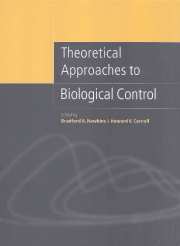Book contents
- Frontmatter
- Contents
- List of contributors
- Preface
- Part I Biological control theory: past and present
- Part II Ecological considerations
- Part III Spatial considerations
- Part IV Genetic/evolutionary considerations
- Part V Microbes and pathogens
- 17 The dynamics of insect–pathogen interactions
- 18 Host–pathogen–parasitoid systems
- 19 Persistence of natural enemies of weeds and insect pests in heterogenous environments
- 20 Application of insect–pathogen models to biological control
- 21 Dose–response relationships in biocontrol of plant disease and their use to define pathogen refuge size
- Index
20 - Application of insect–pathogen models to biological control
from Part V - Microbes and pathogens
Published online by Cambridge University Press: 13 August 2009
- Frontmatter
- Contents
- List of contributors
- Preface
- Part I Biological control theory: past and present
- Part II Ecological considerations
- Part III Spatial considerations
- Part IV Genetic/evolutionary considerations
- Part V Microbes and pathogens
- 17 The dynamics of insect–pathogen interactions
- 18 Host–pathogen–parasitoid systems
- 19 Persistence of natural enemies of weeds and insect pests in heterogenous environments
- 20 Application of insect–pathogen models to biological control
- 21 Dose–response relationships in biocontrol of plant disease and their use to define pathogen refuge size
- Index
Summary
Introduction
The development of insect pathogens as control agents requires a comprehensive understanding of pest–pathogen dynamics if their full potential is to be realized. Aspects of the ecology of both pest and pathogen, however, can be difficult to measure. As a consequence, identification of the key factors that influence the dynamics of the pest–pathogen interaction can be difficult. In this context, mathematical population models can provide useful tools to focus limited research capability on the collection of the most relevant information. Furthermore, adequately validated population models permit the investigation of control options without the need for full field implementation. As such they can prove useful in the development and evaluation of optimum control strategies within an Integrated Pest Management (IPM) framework.
In this chapter we describe the development and application of population dynamic models to investigate the potential of the fungal entomopathogen Metarhizium flavoviride Gams and Rozsypal (Deuteromycotina: Hyphomycetes) for the biological control of locusts and grasshoppers. The factors considered in model development are discussed and results of some parameterization experiments are presented. We show how the models are used to assess population fluctuations and reductions arising from spray applications of a biopesticide based on the pathogen and demonstrate how ecological approaches can provide a link between laboratory and field studies, thereby aiding the interpretation of field trial results.
- Type
- Chapter
- Information
- Theoretical Approaches to Biological Control , pp. 368 - 384Publisher: Cambridge University PressPrint publication year: 1999
- 7
- Cited by

